Articles Menu
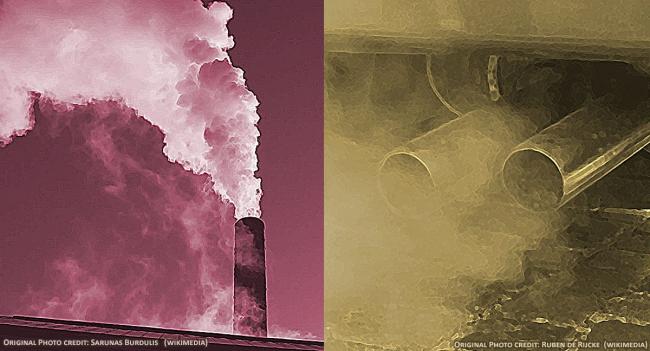
[Editor: But shouldn't we be putting our efforts into public transit not buying EVs? see: Deconstructing Electric Vehicles on the eve of Glasgow COP26 https://ecosocialistsvancouver.org/article/deconstructing-electric-vehicles-eve-glasgow-cop26]
Oct. 26, 2021
Coal is often called the most climate-polluting fuel. That's because coal power plants emit huge amounts of CO2 relative to the amount of energy they produce. Such extreme "CO2 intensity" has made "consigning coal to history" a top goal for this year's international climate conference.
While coal power plants are indeed too carbon-intensive for a safe climate future, our gasoline-burning cars and trucks are even worse.
Take a look.
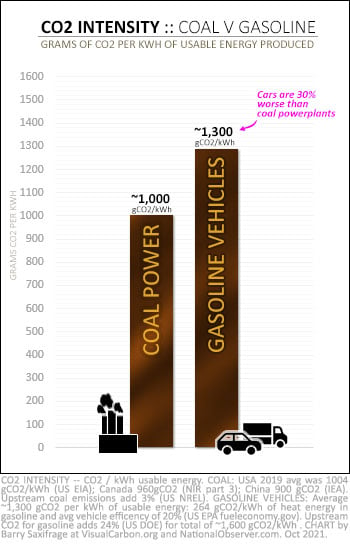
My first chart compares the CO2 intensity of coal power plants and gasoline-powered vehicles.
Coal power plants dump around 1,000 grams of CO2 out their smokestacks for every kilowatt-hour of usable energy they produce (gCO2/kWh).
Gasoline cars and trucks, in comparison, pump around 1,300 gCO2 out their tailpipes for every kWh of usable energy they produce. That's one-third more climate-polluting than coal power plants for the same amount of energy.
(Note: The values for the CO2 intensity of gasoline vehicles used in this article are the author's calculation based on data from the U.S. Environmental Protection Agency (EPA). For details on this and the other data used in this article, see the geeky endnotes.)
The reason gasoline cars and trucks are so much more climate-polluting is that they are so much less efficient than coal power plants.
According to the EPA, car engines convert just one-fifth of the heat energy in gasoline into work energy that turns the wheels. The other four-fifths of the energy gets lost as waste heat and friction. Unfortunately, that's about as good as the laws of thermodynamics and real-world friction allow vehicle engines to be.
Coal power plants, in contrast, convert around two-fifths of the heat energy in coal into energy that can do work (electricity). They are twice as efficient as gasoline engines.
Analysis: While coal power plants are indeed too carbon-intensive for a safe climate future, our gasoline-burning cars and trucks are even worse. Columnist @bsaxifrage shows us why. #CO2 #ClimateCrisis
Put another way, gasoline vehicles need to burn a lot more fuel to produce the same amount of useful energy. That results in more emissions for the same energy.
Gasoline has another big climate strike against it. Producing gasoline takes a lot more energy — and therefore causes more emissions — than producing coal. When these "upstream" production emissions are included, the climate pollution gap grows even wider.
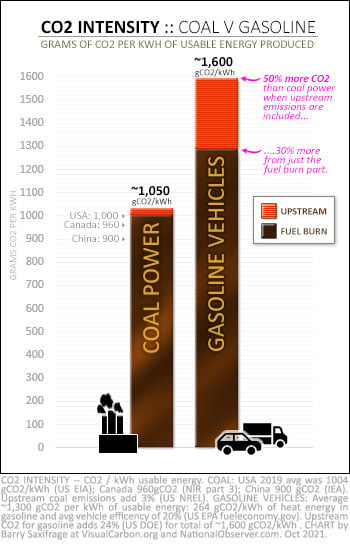
My next chart lets you see this by adding upstream emissions as orange bars.
Digging up coal increases its emissions by around three per cent. That doesn't change its overall CO2 intensity much.
Producing gasoline, however, adds around 24 per cent in extra emissions. That's eight times more upstream emissions than for coal.
As a result, the full "wells-to-wheels" CO2 intensity for gasoline cars and trucks jumps up to around 1,600 gCO2/kWh — 50 per cent higher than coal power plants.
In Canada, that gap is wider still. That's because our coal plants are a bit newer and cleaner than what I show on the chart, which is the American average. Canada's coal power averages around 960 gCO2/kWh. Newer coal technology is less CO2 intensive. For example, China's coal power — with lots of newer and higher-efficiency plants — averages 900 gCO2/kWh. And the very newest ultra-supercritical coal plants can now produce electricity at 750 gCO2/kWh. That's just half the CO2 intensity of today's gasoline vehicles.
If coal power plants are far too CO2-intensive for a safe and sane climate future, then the even more climate-damaging gasoline power plants in our vehicles are too.
So far, we've looked at the CO2 intensity of coal power versus cars. Let's now look at the total climate pollution emitted by each in Canada.
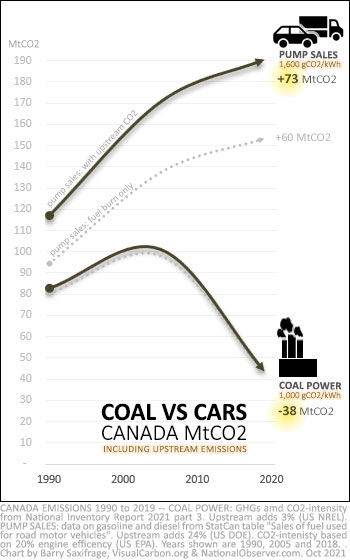
The good news, as my next chart shows, is that Canadians have been reducing total emissions from our coal power plants.
The lower black line shows that Canada's annual coal power plant emissions fell by 38 million tonnes of CO2 (MtCO2) since 1990. Shutting down coal power plants has been our one big climate success in Canada so far.
The bad news is that all our hard-won climate progress on coal pollution has been wiped out by our even larger surge of emissions out our tailpipes.
As the top black line on the chart shows, the climate pollution from the gasoline and diesel we pump into our cars and trucks has jumped by 73 MtCO2 per year since 1990. These pump sales include both passenger and freight vehicles.
So, for every coal power plant we've managed to close in Canada, we've opened the equivalent of two more — via the millions of gasoline power plants in our cars and trucks. To make matters worse, the new ones are even more CO2-intensive than the ones we closed.
One step forward and two steps back. It's no wonder Canada's emissions keep going up, up, up.
What's the alternative?
Powering vehicles of all shapes and sizes with Canadian electricity is less climate-polluting than burning gasoline. My next chart shows just how much less.
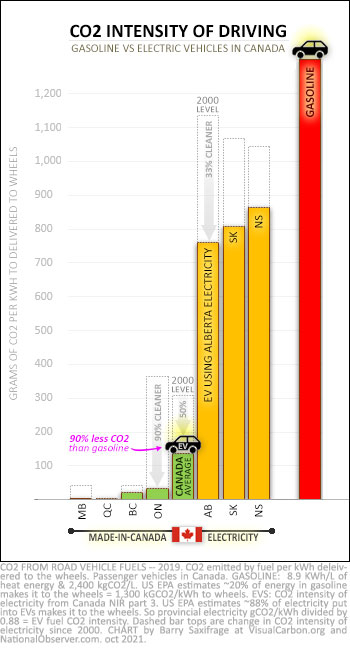
Gasoline is shown by the tall red bar. That's the CO2 intensity of 1,300 gCO2/kWh discussed above.
Compare that to the orange and green bars. They show the CO2 intensity of powering an electric vehicle (EV) with made-in-Canada electricity.
Let's start by looking at the tallest green bar with the little EV car on top. That shows the average for Canadian electricity. It powers an EV at around 135 gCO2 per kWh delivered to the wheels. That's 90 per cent less climate pollution than with gasoline.
As a climate bonus, Canadian electricity is getting cleaner every year. Gasoline isn't. The dashed boxes above the green and orange bars on the chart show how much cleaner each electricity supply has become since 2000.
For example, the dashed box above the green bar for Canadian average electricity shows that overall, the nation's electricity is 50 per cent less climate-polluting than in 2000. Ontario's electricity is now 90 per cent cleaner.
The remaining green bars show the CO2 intensity of driving on the electricity in Ontario, Quebec, B.C., and Manitoba. Eight out of 10 Canadians live in one of these super-clean electricity provinces. All of them have electricity that is at least 97 per cent less climate-polluting as a vehicle fuel than gasoline. In Quebec and Manitoba, electricity is 99.9 per cent cleaner than gasoline.
But even in the "dirty electricity" provinces shown by the orange bars — like Alberta, Saskatchewan, Nova Scotia — electricity is still significantly less climate-polluting than gasoline. And again, all those electricity supplies are getting cleaner.
The good news here is that Canada has some of the least climate-polluting electricity in the world. If we powered our vehicles with it — instead of gasoline — we'd also have one of the world's cleanest and climate-safest vehicle fleets in the world.
The bad news is that, so far, we are sticking with gasoline.
When Canadians go to buy a new car or truck, very few are choosing one that can be fuelled with climate-safer electricity.
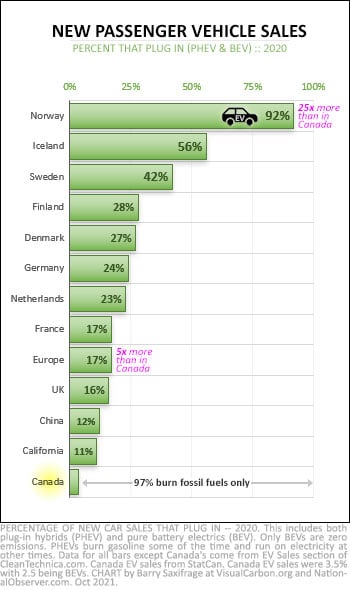
Last year, just three per cent of the new passenger vehicles bought by Canadians had a plug.
That's far fewer than our peers are buying in many other nations. The green bars on my chart show EV sales so far this year as reported by the ever-informative CleanTechnica.
Europeans overall are opting to buy electric-powered vehicles five times more often than Canadians are.
The Germans are choosing plug-ins for a quarter of their new cars. The Swedes are sprinting towards 50 per cent electric-powered.
And, famously, the Norwegians are now choosing EVs for more than 90 per cent of their new passenger vehicle purchases. They're a major oil-producing nation, on the scale of Alberta, and they are choosing the climate-safer electric power option nearly every time.
Canadians are doing just the opposite. We are choosing gasoline burners for 97 per cent of the new passenger vehicles we buy. Thirty years after we first promised to cut our oversized climate pollution, we still continue to drag our feet on choosing the climate-safer options that are right in front of us.
And while Canada is at the bottom of this particular list, there is another list where we are at the very top.
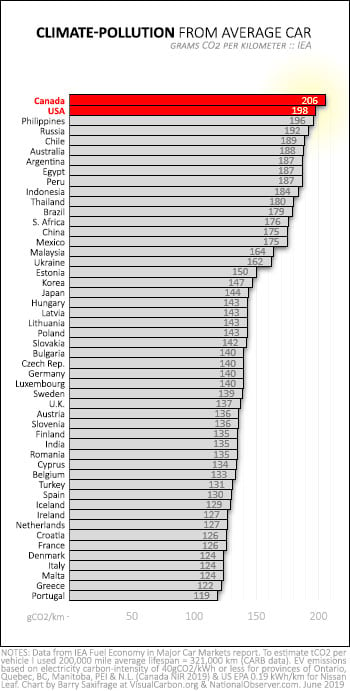
According to the International Energy Agency (IEA), Canadians are choosing to buy the world's most climate-polluting passenger vehicles.
Each one emits 206 gCO2 per kilometre, on average.
As the chart shows, Canadians are choosing to emit 20 per cent more climate pollution every kilometre than the Chinese are. That rises to a climate-hammering 50 per cent more CO2 every kilometre compared to the new cars bought by the British, French, and Germans.
As we saw at the top of this article, all gasoline cars and trucks emit more CO2 per unit of energy than coal power plants. What this IEA data shows is that Canadians are also choosing the gasoline vehicles that require the most energy to travel each kilometre. We are buying the world's biggest "coal plants" on wheels to get around.
Every minute, Canadians buy three more brand-new gasoline-burning passenger vehicles. Each one will go on to burn an average of 21 tonnes of gasoline, emitting 66 tonnes of CO2 out the tailpipe. These are locking in another million tonnes of future CO2 every three days. And all those new gas-burners will still be hyper-emitting with every kilometre well beyond 2030.
This is what climate failure looks like — locking in a transportation fleet that's even dirtier to use than coal power.
Why are we so out of control with our vehicle emissions in Canada? One big reason, as I covered in my last article, is that our federal and provincial governments have kept the price very low to climate-pollute out our tailpipes. Canadians pay far less in gas taxes than is the average across the OECD and G7 nations. In fact, Canadians pay hundreds of dollars less for each tonne of CO2 emitted out the tailpipe than our peers do in most of these other nations. And Canada's ballyhooed carbon tax — scheduled to rise to $170 per tonne of CO2 by 2030 — is far too tiny to bring us level with what most other nations charge in gasoline taxes today.
What all these charts and data make clear is that the gasoline we pump into our vehicles has been driving climate failure in Canada for decades now. And while we have a good alternative in low-CO2, made-in-Canada electricity to power our vehicles with, we're dragging our feet on switching to it. Instead, Canadians are still choosing — 97 per cent of the time — to buy the world's most climate-polluting option for our new cars and trucks.
Climate denial in Canada isn't something that only happens in the oilsands, pipeline, and fracking industries. It is also happening on our streets and in our garages all across the nation.
If we want to become climate leaders instead of perennial climate foot-draggers, Canadians will need to stop buying new dirtier-than-coal gasoline power plants every few seconds. These are driving us all right off the climate cliff.
-------------------------
The geeky endnotes.
For those wanting a deeper dive into the coal power and gasoline power calculations and data sources used in this article, here's the next level down that rabbit hole.
The CO2 intensity of gasoline power versus coal power — Gasoline is often thought of as less climate-polluting than coal because it emits less CO2 for each unit of heat energy that is given off when burned. And, indeed, coal is the more CO2-intensive fuel for heating.
But we don't burn gasoline for heating. What we really want from our gasoline is the power to move our cars. That's a more organized form of energy called "work energy." The electricity produced in coal power plants is also this same organized "work energy."
Unfortunately — as the chart below shows — gasoline power plants in vehicles are far less efficient than coal power plants at transforming the heat energy given off by burning fossil fuels into the work energy we need.
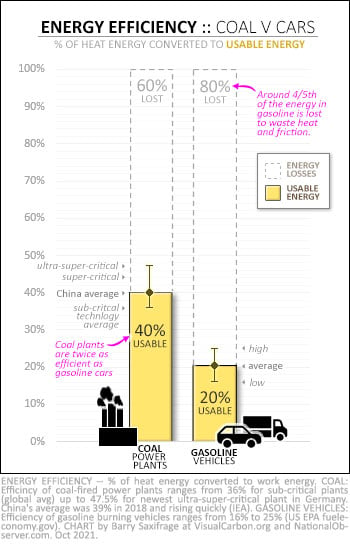
According to the EPA, gasoline engines only convert around 20 per cent of the heat energy into work energy (to turn wheels). This ranges from 16 per cent to 25 per cent depending on driving conditions. In this article, I used 20 per cent for the calculations and charts.
Coal power plants convert ~36 per cent to ~47 per cent of heat energy into work energy (electricity), depending on the technology. The global average for older, sub-critical plants is 36 per cent. The newer super-critical ones are around 44 per cent efficient. And the best new ultra-super-critical plants achieve 47 per cent. In this article, I used the real-world average for the U.S. of ~1,000 gCO2/kWh. That's at the low end of the range, at around 36 per cent.
Here are the data and calculations I used in the article:
Heat energy
Heat to work conversion efficiency
CO2 intensity for work energy produced
Diesel versus gasoline — In the article, I only discuss "gasoline" for simplicity and because 95 per cent of passenger vehicles in Canada burn gasoline. Diesel cars and trucks have a similar CO2 intensity as gasoline cars.
It is often noted that diesel engines can be a bit less CO2-intensive than gasoline engines. But studies of real-world driving show most or all of this benefit gets lost before getting to the wheels. For example, this study by the International Council on Clean Transportation (ICCT) concluded: "A modern gasoline vehicle can have the same or even lower CO2 emissions than a comparable diesel version."
One big reason is that diesel vehicles require a lot of extra energy to filter out the higher levels of NOx gases. Trying to avoid that energy penalty was the motivation behind the Dieselgate emissions cheating scandal by VW and others. In addition, diesel vehicles are often heavier and have more powerful engines, further eroding the real-world efficiency for them.
Upstream emissions — Upstream emissions are emitted during the extracting, refining, and transporting of coal and gasoline. Here are the values I used in my calculations and charts:
CO2 efficiency of electric-powered vehicles — Here are some key stats and calculations I used in the article and charts:
[Top image: Gasoline cars are even more CO2-intensive than coal power plants. And in Canada, it is gasoline, not coal, that has been driving climate failure. Original photo credits Sarunas Burdulis and Ruben de Rijcke (Wikimedia)]